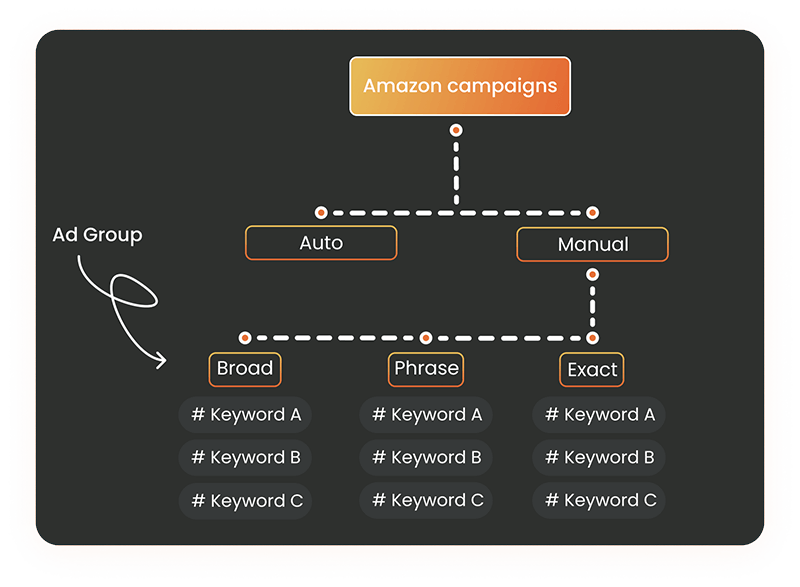In today’s fast-paced digital world, ecommerce has become an indispensable part of our lives, and Amazon stands as a testament to this transformation. Since its beginnings as an online bookstore in 1994, Amazon has grown into a global marketplace that offers entrepreneurs and small businesses a platform to reach millions of customers worldwide. With its vast product selection, advanced logistics infrastructure, and customer-centric approach, Amazon has become an ecommerce giant and a game-changer for businesses of all sizes.
The aim of this guide is to help aspiring Amazon sellers unlock their full potential by providing a host of different techniques for efficient selling on Amazon. For all newcomers venturing into the world of online retail, this guide will serve as a valuable resource to help you navigate the complexities of Amazon selling and harness the platform’s immense potential for your business’s growth and success.
Contents:
1. How to sell efficiently on Amazon
2. Managing inventory and shipping on Amazon
3. Promoting your products and growing your business as an Amazon seller
4. Understanding Amazon’s performance metrics
5. Common issues when selling your products on Amazon
6. Building and maintaining customer relationships
7. How Synder helps to sell efficiently on Amazon
8. Expanding your Amazon selling to international markets
How to sell efficiently on Amazon
Achieving efficiency in your selling strategies is key to success on Amazon. But with myriad sellers, complex algorithms, and demanding customers, selling on Amazon can often seem like navigating through a labyrinth.
We’ll break down the key components of efficient selling on Amazon, providing you with practical strategies to optimize your listings, enhance your product visibility, manage inventory, provide stellar customer service, and ultimately, boost your sales. Let’s unravel the secrets to mastering the art of selling on Amazon.
Creating effective product listings on Amazon
Product listings are a crucial component of a successful selling strategy. An optimized listing not only attracts potential customers but also influences their purchasing decisions, directly impacting your conversion rates and sales.
This process involves several key elements, including accurate and engaging titles, high-quality images, detailed and persuasive product descriptions, strategic keyword usage, and competitively priced offerings.
Additionally, understanding and adhering to Amazon’s product listing guidelines is critical to maintaining your seller account’s health and performance. Ultimately, a well-crafted product listing can significantly enhance your visibility, credibility, and customer trust, paving the way for long-term success on Amazon.
Keyword optimization
Performing keyword research is a critical step. Leverage tools such as Amazon’s autocomplete feature, keyword research tools, and competitor analysis to identify relevant, high-traffic keywords for your products. These keywords should accurately represent your product and align with the search terms potential customers would use.
Your primary keywords should be incorporated into the product title. However, it’s important to ensure the title remains readable and informative. The title should provide a clear and concise snapshot of what your product is, incorporating keywords in a natural and meaningful way.
Make full use of bullet points and product descriptions. Here, you can include secondary keywords and variations, always focusing on the most important features and benefits of your product. Well-crafted bullet points and descriptions not only boost your SEO but also provide valuable information to potential customers, helping them make informed purchasing decisions.
Finally, don’t overlook the power of backend keywords. Adding relevant secondary keywords in the backend search terms of your Amazon listing can significantly improve your product’s search visibility. The best part is that this strategy enhances your SEO without affecting the customer experience, as these keywords aren’t visible to customers but are indexed by Amazon’s search algorithm.
High-quality product images
To start with, you should upload clear, high-resolution images that effectively showcase your product’s features and quality. Crisp and detailed images can give potential buyers a better understanding of what they’re purchasing, thereby increasing their confidence in your product.
Secondly, make sure to provide multiple images from different angles, along with close-up shots. These additional photos can highlight important details and features that might not be apparent in the main image. By offering various perspectives, you allow customers to get a comprehensive visual understanding of your product.
It’s equally important to ensure your images comply with Amazon’s guidelines. For instance, the platform requires the main image to have a white background and supports specific file formats. Adhering to these guidelines is critical to avoid any potential listing issues and to provide a consistent customer experience.
Lastly, consider using lifestyle images and infographics. Lifestyle images, which show your product in use, can help customers visualize how the product fits into their life. Infographics, on the other hand, can illustrate key features or specifications in an easy-to-understand format. Both these elements can add value to your product listing and enhance your product’s appeal.

Compelling product descriptions
It’s important to focus on the key benefits of your product and illustrate how it solves a customer’s problem or meets their needs. Rather than just listing product features, try to show customers how those features will provide value or improve their life. This helps customers envision the product’s practical use, thereby increasing its appeal.
The writing style also plays a crucial role. Ensure you use clear and concise language that’s easy for your customers to understand. Avoid technical jargon and lengthy paragraphs that may confuse or overwhelm readers. Your aim should be to communicate effectively and persuasively about your product’s benefits, so simplicity and clarity are key.
Additionally, the format of your product description matters greatly for readability. Break up your text with headings, bullet points, and short paragraphs to make it more readable and easily scannable. A well-structured description allows customers to quickly find the information they need, improving their shopping experience.
Last but not least, make it a point to address potential objections within your product description. By anticipating and tackling any potential concerns or objections that customers might have about your product, you can build trust and make it easier for them to make a buying decision. This proactive approach shows that you understand your customers’ needs and can significantly improve your conversion rates.
Utilizing Amazon‘s Enhanced Brand Content (EBC)
Using Enhanced Brand Content (EBC) on Amazon can significantly improve your product listings by providing a more detailed and visually engaging description of your products. However, to access EBC, you need to ensure you’re enrolled in Amazon Brand Registry and have an active professional seller account. These prerequisites confirm your legitimacy as a brand owner and open up additional marketing features for your use.
EBC allows you to create customized, visually appealing content for your product listings. You can incorporate additional high-quality images, videos, and descriptive text to tell your brand story and showcase your product’s unique features. This enriched content goes beyond standard product descriptions, enabling you to highlight the value of your product in a more engaging and effective way.
With a significant portion of Amazon shoppers browsing and making purchases on their mobile devices, it’s critical to optimize your EBC content for mobile viewing. Ensure your text is easily readable, images are clear, and the overall layout remains appealing and coherent on smaller screens. Mobile optimization is a key factor in providing a seamless shopping experience for your customers.
Finally, it’s important to regularly monitor the performance of your EBC content. Use the available analytics to understand how your content impacts your conversion rates and overall sales. Based on these insights, make necessary adjustments to improve its effectiveness, which could involve tweaking the design, changing the text, or updating images or videos. This continuous improvement process will help you maximize the benefits of EBC for your Amazon listings.
Find out about the best products to sell on Amazon FBA with our comprehensive guide on top-selling items.
Pricing strategies
Pricing strategies are paramount to determining how your product fares in the vast Amazon marketplace. With the right approach, you can drive more traffic to your listings, boost conversion rates, and increase your overall sales.
Competitive pricing
Competitive pricing strategy is often the first step to determining how to price your product. Begin by conducting a comprehensive analysis of your competitors’ prices and product offerings. Then, strategically position your price point to be competitive while ensuring you still make a profitable margin. It’s a delicate balance between being affordable enough to attract customers and expensive enough to cover costs and generate profit.
Value-based pricing
Value-based pricing, on the other hand, shifts the focus from what the market is willing to pay to the perceived value of your product. This means pricing your products based on the benefits they provide to the customers, which might be superior to those offered by competitors. For instance, if your product offers a unique feature or a superior quality that sets it apart, you could justify a higher price point.
Dynamic pricing
This type of pricing involves continually adjusting your prices in response to market fluctuations, competitor pricing, and changes in demand. For example, if your competitors run out of stock for a particular item, you may want to slightly increase your price due to increased demand. Similarly, during a period of lower demand, it might be more beneficial to lower your prices to stimulate sales.
Managing inventory and shipping on Amazon
Efficiently managing inventory and shipping on Amazon is key to customer satisfaction and profitability. This involves accurate demand forecasting, regular inventory audits, and effective shipping strategies. By streamlining these processes, you can ensure smooth operations and a positive customer experience.
Inventory management best practices for Amazon selling
Effective inventory management is essential for running a successful Amazon business. The following best practices can help you maintain optimal stock levels, avoid costly mistakes, and enhance operational efficiency.
Accurate forecasting
By analyzing your sales data, industry trends, and seasonal fluctuations, you can predict future demand more accurately. This helps you avoid stockouts, which can lead to missed sales opportunities, or overstocking, which ties up your capital and storage space.
Regular inventory audits
Periodically perform physical counts of your inventory. This can ensure the accuracy of your inventory records and let you quickly identify any discrepancies. An inventory audit helps prevent issues such as overselling or lost inventory.
Inventory management software
A reliable system can track inventory levels, sales, and orders in real-time, significantly reducing the risk of errors and improving overall efficiency. It can also provide valuable insights and alerts to help you manage your inventory more effectively.
Setting reorder points
This is a key strategy for maintaining optimal stock levels. By establishing minimum and maximum inventory levels, you can determine when to reorder products. This helps ensure you have enough stock to meet demand without holding excessive inventory.
Prioritization
Finally, prioritizing your inventory can help you allocate resources more effectively. Using methods such as ABC analysis, you can categorize your inventory based on its importance or sales velocity. This allows you to focus your attention and resources on the most valuable or fast-moving items, improving your inventory turnover and profitability.
Tips for reducing shipping costs
To maximize profitability as an Amazon seller, it’s important to consider reducing shipping costs. Let’s look at the strategies that can significantly cut down on your operational expenses and enhance your bottom line.
Negotiation
One of the first steps is to negotiate with carriers. Leverage your shipping volume and history to negotiate better rates and terms with shipping carriers. This can result in significant savings, especially if you ship large volumes or high-value items.
Cost-effective packaging
Opt for lightweight, durable packaging materials that protect your products while minimizing shipping costs. The right packaging can reduce weight and space requirements, leading to lower shipping charges. Optimizing shipping dimensions is also important. Use the smallest possible packaging size that still adequately protects your products. This can help you avoid extra fees associated with dimensional weight charges, which are based on package size rather than actual weight.
Consolidation of shipments
Whenever possible, combine multiple orders going to the same destination. This can result in substantial savings, particularly for international shipments or deliveries to remote locations.
Discounted shipping services
Many carriers and third-party shipping providers offer discounted rates for businesses. These discounts can significantly reduce your shipping costs and help improve your bottom line, so it’s always a good idea to research and inquire about those lower rates.
Promoting your products and growing your business as an Amazon seller
There are numerous ways in which you can advertise on Amazon. Some are part of Amazon Advertising, while others are external software that you can use to showcase your products.
Amazon advertising
There are a few ways in which Amazon helps the sellers showcase and advertise the products.
Sponsored Products with Amazon
Sponsored Products are cost-per-click (CPC) ads that promote individual product listings on Amazon. They appear in search results and on product detail pages, helping to increase visibility and drive sales for specific products.
Sponsored Brands with Amazon
These ads promote your brand and a selection of your products. They appear in prominent locations in search results and help increase brand awareness and customer engagement. Sponsored Brands ads require enrollment in Amazon Brand Registry.
Sponsored Display with Amazon
These ads are targeted display ads that can appear on and off Amazon, including product detail pages, search results, and third-party websites. Sponsored Display ads can help you reach a wider audience, retarget shoppers who viewed your products, and increase sales.
Utilizing Amazon deals and promotions
Lightning Deals, Coupons, and Promotions are among the powerful marketing tools Amazon provides to its sellers to help boost sales and increase product visibility.
Lightning Deals on Amazon
Lightning Deals are limited-time, promotional offers that are prominently featured on Amazon’s Deals page. These highly visible deals can create a sense of urgency among potential customers, driving significant traffic to your products and potentially leading to a boost in sales. However, it’s important to note that Lightning Deals require a fee and are subject to Amazon’s approval.
Coupons on Amazon
These provide discounts on specific products that customers can redeem at checkout. Not only can coupons help move more units, but they can also increase your product visibility on the platform. Amazon marks products with coupons with a special badge, making them stand out in search results and on product detail pages.
Promotions on Amazon
They allow you to offer various types of deals to your customers, such as buy one get one free (BOGO), percentage off, or free shipping. Creating promotions can help you increase sales volume, clear out inventory, and reward loyal customers. They can be particularly useful during the holiday season or when you want to push a new product.
External marketing strategies
Strategies such as social media marketing, email marketing, content marketing, influencer marketing, and search engine optimization (SEO) can significantly amplify your reach, drive traffic to your Amazon listings, and boost sales. Let’s look at them more closely.
Social media marketing
It’s a powerful tool to promote your products and engage with your audience. Platforms like Facebook, Instagram, Twitter, and Pinterest can be utilized to showcase your products, share customer testimonials, and announce new product launches or promotions. These platforms offer a unique opportunity to interact directly with your customers, fostering a community around your brand and driving traffic to your Amazon listings.
Email marketing
By building an email list and regularly sending newsletters, promotions, and product updates, you can keep your brand at the forefront of your customer’s minds and incentivize them to make repeat purchases or generate referrals.
Content marketing
It involves the creation of blog posts, articles, videos, or other content related to your products and industry. This content can be shared on your website, social media, or other platforms to drive traffic, increase brand awareness, and establish your brand as an authority in your niche.
Influencer marketing
It’s a strategy that involves collaborating with influencers in your niche to promote your products. This can help you reach new audiences, gain credibility, and increase sales. When influential individuals, who have their own dedicated followers, endorse or review your products, it can lead to increased trust and interest in your offerings.
Search engine optimization (SEO)
Finally, search engine optimization is critical for driving organic traffic and increasing visibility. By optimizing your website and content for relevant keywords, you can improve your search engine rankings, making it easier for potential customers to find your products.
Each of these strategies can be effective in its own right, but a combination of these methods often yields the best results. They provide different avenues to reach potential customers, promote your products, and drive more traffic to your Amazon listings.
Understanding Amazon‘s performance metrics
Amazon uses various performance metrics to evaluate sellers and ensure they maintain high standards of customer service. They also offer valuable insights into your business performance and customer satisfaction levels. Some key metrics include:
- Order Defect Rate (ODR): The percentage of orders with negative feedback, an A-to-z Guarantee claim, or a credit card chargeback.
- Pre-Fulfillment Cancel Rate: The percentage of orders canceled by the seller before shipment confirmation.
- Late Shipment Rate: The percentage of orders with a shipment confirmation submitted after the expected ship date.
- Valid Tracking Rate: The percentage of orders with valid tracking numbers submitted on time.
- Return Dissatisfaction Rate: The percentage of returns with negative customer feedback about the return process.
Regular monitoring and optimization of these metrics can help improve your seller rating, enhance your product visibility, and boost your overall sales on Amazon. It’s crucial to familiarize yourself with these metrics and use them as key indicators to guide your business strategy and decision-making process.
Common issues when selling your products on Amazon
Navigating the world of Amazon selling presents its unique set of challenges, from understanding customer preferences to effective advertising and comprehensive reporting.
Insufficient understanding of customers’ needs
Without this knowledge, no amount of traffic generation or product variety will yield meaningful results. However, manually identifying specific buying patterns can be a time-intensive process. As you spend time on analysis, competitors continue to grow, altering the competitive landscape before you can implement your findings.
Missalined advertising
Advertising your product appropriately is pivotal. Common pitfalls include over- or under-advertising, improper keyword or call-to-action usage. The online marketplace is saturated with sellers offering similar products. Without a strategic, targeted approach to advertising, your product may get lost in the crowd. Implementing effective advertising strategies requires time and focus, which can divert attention from your core business operations.
Time-consuming financial reporting
Reporting is an essential yet challenging aspect of selling on Amazon. Profit and loss (P&L) reports provide valuable insights, revealing which products sell, who your customers are, where losses occur, and more. However, creating actionable and usable P&L reports can be a daunting, time-consuming task.
While these challenges may seem overwhelming, they are surmountable with the right solutions in place. With a strategic approach to understanding customer behavior, effective advertising, and efficient reporting, you can successfully navigate these common problems and thrive as an Amazon seller.
Mayan software: A fast and easy solution
Developed by data scientists from MIT, Mayan is an innovative solution that enables the creation and optimization of PPC campaigns for Amazon Ads. Offering comprehensive services to Amazon sellers, Mayan provides cutting-edge automation tools for devising ad strategies and personalizing media planning.
Analyzing your Sales
With this tool, you can analyze your customers’ needs and predict what products will be in demand. Analyze your sales at all levels across all Amazon marketplaces.
As the software is constantly evolving, the new feature connected with tracking your competitors will also be of great help.
Optimizing your Advertising
Mayan will be the right choice for increasing your ROAS. The platform helps you optimize your ad spend so that you are always aware that every dollar you put into
advertising is worth it. You can record the growth of your business with powerful technology.
The following chart represents the structure of your campaigns, which should be strategically designed by utilizing a blend of automated and manual campaigns, in addition to leveraging technology-enabled targeting strategies.

Building and maintaining customer relationships
The relationship with your customers is pivotal to your success on Amazon, as it increases overall sales, repeated purchase frequency, and loyalty. Each of the following techniques is a piece of the puzzle in building a successful Amazon business, and when put together, they can create a powerful strategy for growth.
Provide exceptional customer service
The importance of providing exceptional customer service in your Amazon business can’t be overstated. Promptly responding to customer inquiries, professionally addressing any issues that arise, and consistently exceeding customer expectations can significantly improve your seller reputation and customer satisfaction.
Customer service isn’t just about resolving problems; it’s about creating a positive, memorable experience that encourages customers to return and recommend your products to others – word-of-mouth is a great marketing asset.
Encouraging product reviews
Reviews act as social proof, helping potential customers make purchasing decisions. Request reviews from satisfied customers, always ensuring that your approach aligns with Amazon’s guidelines. Positive reviews can enhance your product’s credibility, improve your product rankings, and ultimately increase your sales.
Personalization
Whether it’s through personalized email marketing, social media interactions, or targeted promotions, making customers feel valued can lead to increased brand loyalty and repeat purchases. Take the time to understand your customers’ needs and preferences, and tailor your communication and offers to match.
Engage with customers on social media
By promptly responding to comments, questions, and messages, you can demonstrate your commitment to customer service, build rapport, and foster a sense of community around your brand. Social media provides a unique opportunity to connect with your customers on a more personal level, making your brand more relatable and approachable.
Post-sale follow-up
Reaching out to customers after a purchase to thank them, ensure their satisfaction, address any concerns, and offer assistance or incentives for future purchases can make a significant difference. This not only shows that you value their business, but also provides an opportunity to address any issues proactively, reducing the likelihood of negative reviews and returns.
By leveraging these strategies, along with Amazon Advertising, Amazon deals, promotions, and external marketing strategies, you can effectively promote your products, increase visibility, and drive sales on Amazon.
How Synder helps to sell efficiently on Amazon
Synder is a comprehensive business management platform that empowers sellers to handle their financial operations with ease and precision. Offering seamless integration with multiple sales channels, automated financial management, and in-depth reporting, Synder significantly simplifies complex financial tasks. Its robust features such as tax management and real-time inventory tracking make it an indispensable tool for businesses looking to streamline their operations and optimize profitability.
Synder isn’t just software; it’s a solution tailored to help your business thrive in a dynamic ecommerce environment.
Seamless integration
Synder integrates effortlessly with Amazon, providing you with a centralized platform to manage your finances, transactions, and inventory across various sales channels. This eliminates the need to switch between different platforms and manual data entry, saving you time and reducing the risk of errors.
Automated financial management
With Synder, financial operations such as transaction recording, reconciliation, and inventory tracking are automated. This means you can spend less time on tedious administrative tasks and focus more on strategic decisions to grow your business.
Comprehensive reporting
Synder’s robust reporting feature provides valuable insights into your business performance. By analyzing detailed financial data captured from all your platforms and gateways, Synder allows you to make data-driven decisions. You can identify top-performing products, monitor trends, and assess the profitability of your business at a glance.
Tax preparation
Synder simplifies tax preparation by accurately tracking and categorizing your income and expenses. This ensures you’re ready for tax season and maintain compliance with tax regulations.
Inventory tracking
With Synder, you can manage your inventory more effectively. The software keeps track of your stock levels in real time, helping you avoid stockouts or overstocking.
To find the full functionality of Synder, book an office hour or sign up for a free 15-day trial.
Expanding your Amazon selling to international markets
Expanding your business to multiple marketplaces can offer several significant advantages, starting with increased revenue potential. By selling on more than one platform, you’re able to reach a larger customer base, which in turn increases your opportunities for sales and revenue. With more customers viewing your products, you naturally have a higher potential for conversions.
Advantages of selling in multiple marketplaces
Selling in multiple marketplaces offers diversification. If your business is dependent on a single platform or market, changes in consumer preferences, platform policies, or market fluctuations could significantly impact your sales. By diversifying, you mitigate these risks and create a more resilient business model.
Access to multiple marketplaces allows for better market penetration. You can enter new markets, explore emerging opportunities, and gain insights into consumer trends in various regions. This expanded market knowledge can inform your business strategy, enabling you to tailor your offerings to meet different market needs and preferences.
Selling in different regions and marketplaces can help you balance seasonal sales fluctuations. Demand for certain products may vary across different markets and time zones. For instance, while summer products may see a decline in sales in one country, they may be in high demand in another. This geographical diversification can lead to more consistent sales throughout the year.
Learn how to start an Amazon FBA business.
Challenges and considerations when selling internationally
While selling in multiple marketplaces offers numerous benefits, it also brings certain challenges and considerations that need to be addressed.
One of the primary challenges is navigating language and cultural barriers. Expanding to international marketplaces may require you to adapt your product listings, customer service, and marketing efforts to accommodate different languages and cultural norms. This can involve translating your listings, modifying your marketing strategies, and offering localized customer support to provide a seamless shopping experience for customers in different regions.
In addition, you need to consider regulatory and legal compliance. Different countries and regions have unique regulations, tax requirements, and import/export restrictions that you must adhere to when selling in multiple marketplaces. This may require substantial research and possibly professional legal advice to ensure compliance.
Another consideration is managing currency conversion and payment processing. Dealing with multiple currencies can be complex and may involve additional fees and costs. Similarly, different marketplaces may use different payment processing systems, which can further complicate transactions and financial management.
Inventory management and logistics also pose a significant challenge when selling in multiple marketplaces. Coordinating inventory and order fulfillment across different regions can be a daunting task. You may need to partner with third-party logistics providers or use fulfillment services like Amazon FBA to manage your inventory and ensure timely and efficient order fulfillment.
Finally, expanding your business to new marketplaces can expose your products to increased competition. You may find yourself competing against local or established sellers who are more familiar with the marketplace and its customers. Therefore, it’s important to thoroughly research each new marketplace and develop a competitive strategy to differentiate your products and attract customers.
How to sell efficiently on Amazon: Closing thoughts
Selling on Amazon offers tremendous opportunities for entrepreneurs and small businesses to reach a global audience and scale their businesses. With dedication, research, and continuous improvement, aspiring Amazon sellers can successfully navigate the competitive landscape and achieve long-term success in the marketplace.
Remember, building a thriving Amazon business takes time, perseverance, and resilience. Stay focused on providing value to your customers, offering high-quality products, and delivering exceptional customer service. These core principles will set the foundation for a long-lasting and successful business.

.png)




